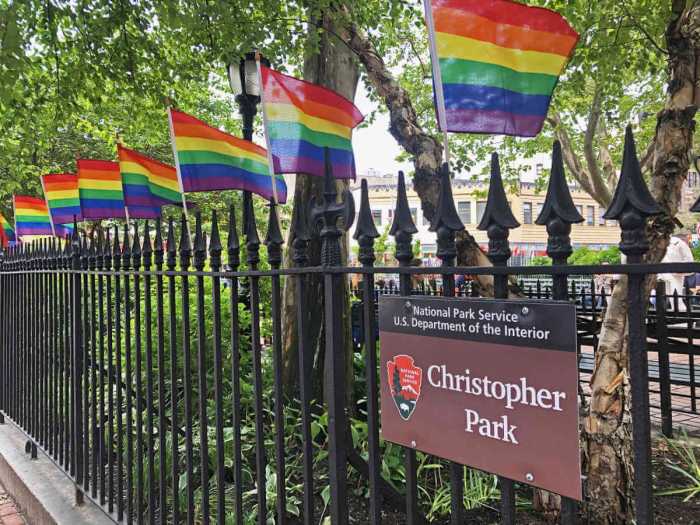Rio de Janeiro gears up to mark 50th anniversary of Carmen Miranda’s death
What could be gayer than dancing in outlandish costumes with a bowl of fruit on your head? The answer perhaps is all the men remaking Carmen Miranda, the ultimate Brazilian symbol, and inspiration for countless gay pride costumes around the world, the center of a Rio de Janeiro celebration beginning in August and lasting until the beginning of next year.
August 5 marks the 50th anniversary of the death of Carmen Miranda in her home in Beverly Hills at the relatively young age of 46. Rio, the city that knows how to party like no other, is throwing a huge celebration in her honor. Gay men in Brazil and in the United States are at the forefront of making sure that Miranda is properly remembere
Since stepping her tiny feet into New York in 1939, no one has more memorably represented Brazil in the American mind than Carmen Miranda. With her fruit-covered turbans, puffy sleeves and sensual hand movements meant to mimic the women of Brazil’s Bahian north, she was an instant Hollywood sensation whose star-earning power rivaled that of actresses like Betty Davis and Joan Crawford.
Ulisses Rabelo is a Rio make-up artist and Carnaval costume designer who had been enamored of Carmen Miranda his whole life. His family had always watched her movies, but he found a special connection to her as a gay man.
“The way she acted, she was always full of happiness, a lot of gestures that are very exaggerated, that’s why I think every gay likes to be like her,” he explained.
Knowing of the impending anniversary, Rabelo wanted to work with the Carmen Miranda Museum, a small institution in Flamengo Park, close to downtown Rio de Janeiro. He said, however, “When I went to the museum, I realized it had a lot of things that belonged to Carmen, but Carmen herself was not here.”
“I wanted to bring her back to life,” he explained, so that Carmen would be reunited with the clothes that made her famous. He is creating 20 busts of her based on photographs, and one full size mannequin that will display the outfit she wore in the movie “Weekend in Havana.”
While he used photos to sculpt Miranda’s face, he did not have to look far to find a model for her body. He used the museum’s secretary, Vilma Santos.
“Vilma has the same size as Carmen Miranda, this is the way to show her in three dimensions,” he explained.
In addition to serving as a model for the mannequin, Santos will wear copies of some of Miranda’s clothes while working in the museum.
A continent north, in Miranda’s adopted homeland of the United States, gay men are also involved in remembering her legacy. Up until May, the world’s largest private collection of Carmen Miranda memorabilia belonged to Alberto Barreto, a gay Rio native who relocated to Chicago in 1960. He had lived in the city’s Eastlake View neighborhood, better known to gays and lesbians as “Boystown” or the Halsted gay-borhood. According to his friend, Stan Pantelis, “Alberto was planning to donate all of his material to the Carmen Miranda Museum,” but he died from surgery complications in January of this year.
“This was so important for Alberto, his friends in America wanted to see it acknowledged,” Pantelis explained.
Pantelis personally made sure that more than 150 items were shipped to Brazil including sheet music, movies struck from the original negatives and rare photographs of Miranda in street clothing going about her daily life.
César Soares Balbi, the director of the Carmen Miranda Museum, cut through some red tape to ensure that the items were received on a timely basis.
“This material will now be part of the patrimony of the nation, and it’s important for Americans to realize what she represents to our culture,” Balbi said.
Balbi will display the new material along with what he has, but space is very tight. Carmen Miranda’s wild costumes are in glass cases, and photos on the wall tell about her life. Clothes, films, jewels and other items are scattered on tables and in drawers in the backrooms. Along one wall of the storage rooms are racks full of headdresses and ornate high platform shoes that lifted her small frame up against Hollywood’s leading men. Miranda was just over five-feet tall, and many of her shoes had six-inch heels.
According to Balbi, a Carnaval-like celebration will be held in front of the museum from August 18 until the end of August, with Miranda as the theme.
“The festival will spill out into the park in front of the museum, and there will be music and singing, and more than likely, people, men and women, dressed as Carmen Miranda,” Balbi said.
Celebrations will be held in other areas of Rio de Janeiro. Though the details are still being worked out, much of the material on display in the Carmen Miranda Museum will move to the larger Museum of Modern Art in October or November. In addition, Miranda’s films will be screened throughout the city. The very first theater where Carmen took to the stage, the Federal University of Rio de Janeiro’s Music School in the Lapa district, will also host performances of her songs. Ironically, the theater is only a block from where Rabelo lives.
A new biography by the Brazilian journalist Ruy Castro will also be released later this year. Even the Brazilian jewelry company H. Stern is creating a special line in Miranda’s honor, and various Brazilian designers have also created new clothing lines based loosely on her costumes.
Balbi is hoping that the festivities for the 50th anniversary of her death are so successful that they serve as practice for an even more important anniversary: February 9, 2009, which will be the 100th anniversary of Miranda’s birth in Portugal, from where her family relocated to Brazil when she was a year old. He is pushing for the State of Rio de Janeiro to build a new museum for her, replacing the one he currently runs.
“We try to maintain the best we can,” he said, “but this museum is not a priority for the government in Rio.”
Indeed, the museum was originally a spaceship-shaped structure in a children’s playground that was converted to house the collection Miranda’s husband, the American David Sebastian, donated to Brazil in 1977. The structure leaks, is not properly air-conditioned and has little room for expansion.
The condition of the Carmen Miranda Museum however, reflects the conflicting tensions that Brazil has towards it most famous icon. Brazil has always been a country of contrasts, both proud, and worried about the way the world perceives it. Miranda was viewed as too over-the-top and too American by many Brazilians who at the time felt she was ridiculing the country by appearing as she did in Hollywood films. Yet in spite of this, she was the most famous representative of the country, and spurred a post World War II tourism boom by encouraging Hollywood’s elite, including Rock Hudson, to visit there for Carnaval balls.
The dead body of Miranda was confronted by these ironies when it was brought back to rest in peace in her beloved city of Rio. While millions of Brazilians mourned for days after her death, Brazil’s conservative church was shocked by how Miranda was dressed by American funeral technicians for her Catholic burial. When the priests opened the coffin, they found her in a brilliant red dress with what they considered far too much make up, according to Rabelo.
“The priests had some of the make-up removed, and her dress covered over for the ceremony,” he explained.
Gays today in Brazil, while accepted and loved in many ways, seem to still suffer from these same opposing views that greeted Miranda 50 years ago. Nilton Almeida, Rabelo’s long-term partner, knows Brazil has a long way to go.
“We’re a very gay country, but we’re very conservative, too,” he said.
More information about Carmen Miranda, and a schedule of activities related to the 50th anniversary of her death can be found at carmenmiranda.net. The Carmen Miranda museum is located in Flamengo Park, along Avenida Rui Barbosa, and open Monday to Friday, 11 a.m. to 5 p.m. and Saturday and Sunday, noon to 5 p.m. The telephone number is 55/21-2299-5586.
gaycitynews.com



































